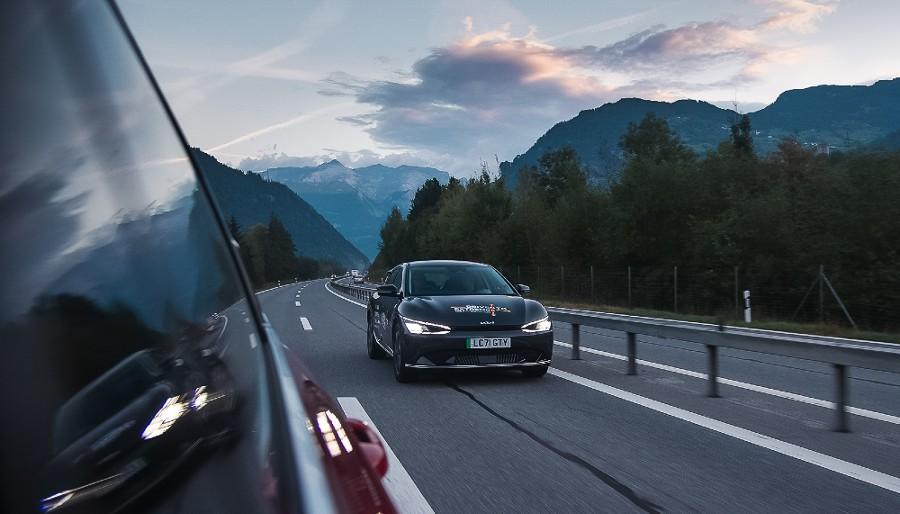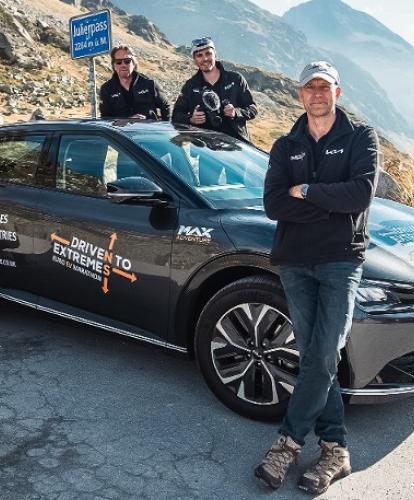The Max Adventure team has completed the Driven To Extremes Euro EV Marathon and driven a fully electric Kia EV6 Air from Oslo, in Norway, to Portugal. The team beat its original target by arriving in just 3.75 days and also added an extra country to its itinerary.
Covering 16 countries and 3,174 miles in a little over 89 hours, the challenge was designed to show how easy it is to cover huge distances in a short time using a standard electric car and existing charging infrastructure. The adventure started as the team were waved off from Kia’s Norwegian headquarters in Oslo, with Kia Portugal in Lisbon welcoming the travellers at the journey’s end.
What’s more, the team improved on the time set by racing legend Sir Stirling Moss, who undertook the drive in 1952, by 47 minutes. This is understood to be the first time the route has been attempted in a fully electric vehicle. Having completed the epic 3,174-mile adventure, the team arrived in Lisbon on 9th September.
“This wasn’t about trying to beat Sir Stirling, but demonstrate that mammoth trans-continental drives in an EV can easily be undertaken here and now in 2022,” said Project Leader Mac Mackenney.
“Many people still view EVs as ineffective or unable to cope as a daily means of transport outside of city life, but the Kia EV6, and the charging network show that just isn’t true.
“We’d like to thank Kia UK, as well as Kia Norway and Kia Portugal, for their support and hospitality, and want to recognise the enthusiasm and kindness we’ve experienced on the road as we’ve travelled from the top of Europe to the bottom.”
Originally intending to cover 15 countries in 120 hours, the team were able to shave more than a day and add an extra stop to their itinerary after it became clear just how quickly they could cover the distance. Only stopping for charging and to change drivers, the team operated in shifts and adhered to the speed limits of each country visited.
Despite recording the journey, the drive wasn’t about setting the fastest time possible, and the team made detours to honour Sir Stirling along the way. This included the 7,500-foot high Julier Pass in the Swiss Alps, part of the original 1952 route, and Monaco, which allowed the team to drive the historic Grand Prix circuit.

The team improved on Sir Stirling Moss’s time by 47 minutes.
Leaving Oslo, the team set a course for the border with Sweden. From there it was destination Denmark before driving through Germany, the Netherlands, Belgium, Luxembourg, France, Switzerland, Liechtenstein, Austria, Italy, Slovenia, Monaco, Spain and finally Portugal.
The team departed on Sunday, 5th September at 15:00 and crossed the border into Portugal, at Vilar Formoso on Thursday, 8th September at 08:12. This marked the start and stop point for the timing – as per the original drive in 1952.
The ‘Driven to Extremes Euro EV Marathon’ was inspired by the adventure undertaken by Stirling Moss in 1952. A publicity stunt to promote the then-new Humber Super Snipe 4-door saloon, the legendary racing driver, along with three of his ‘fast friends’, visited 15 European countries in less than five days.
2022’s challenge gives that journey a modern perspective, and concluded on 9th September. Traveling from Oslo to Lisbon, driving roughly 200-mile legs at a time, and using Europe’s public charging network throughout, the challenge used one of the most accomplished electric vehicles available today.
With a WLTP combined range of up to 328 miles on a single charge, the Kia EV6 ‘Air’ was the perfect car for the Driven To Extremes team to tackle the 3,174-mile marathon. With its spacious cabin and long wheelbase, the car provided comfort during this 89-hour drive, while its 800V ultra-rapid charging technology kept pit stops to a minimum. Capable of taking the battery from 10 to 80 per cent in just 18 minutes when using a 350kW charger, or from 10 to 80 per cent in 1 hour 13 minutes using a 50kW charger, the Kia EV6 allowed the team to pick optimal stopping points along the way.



